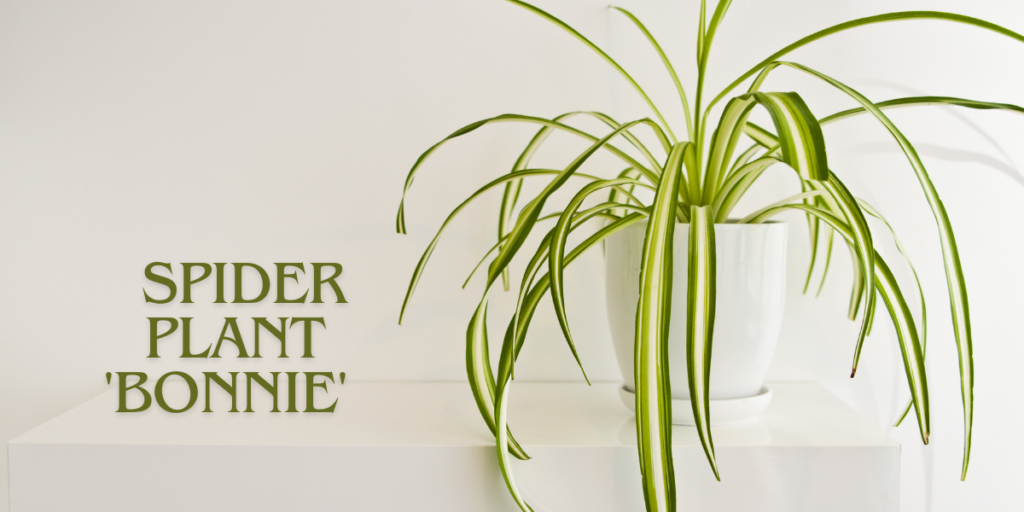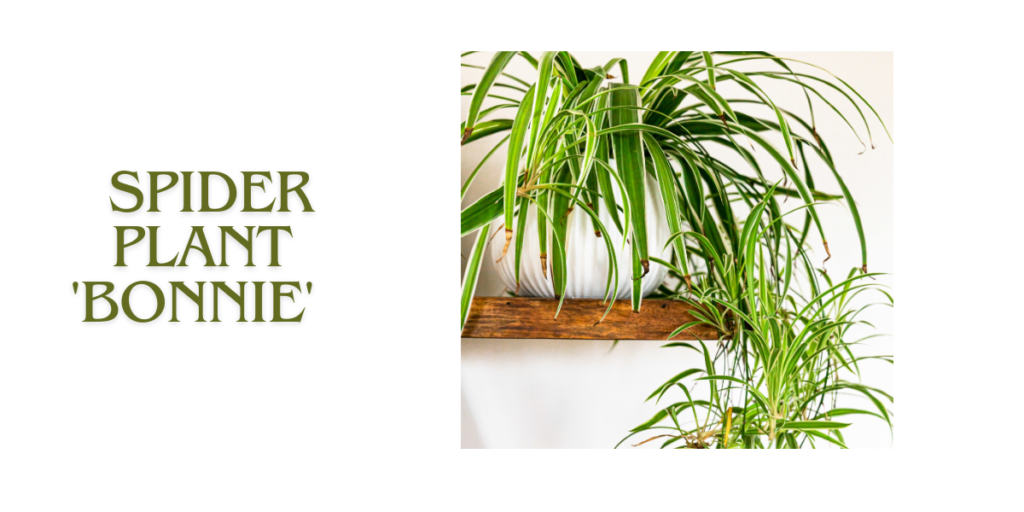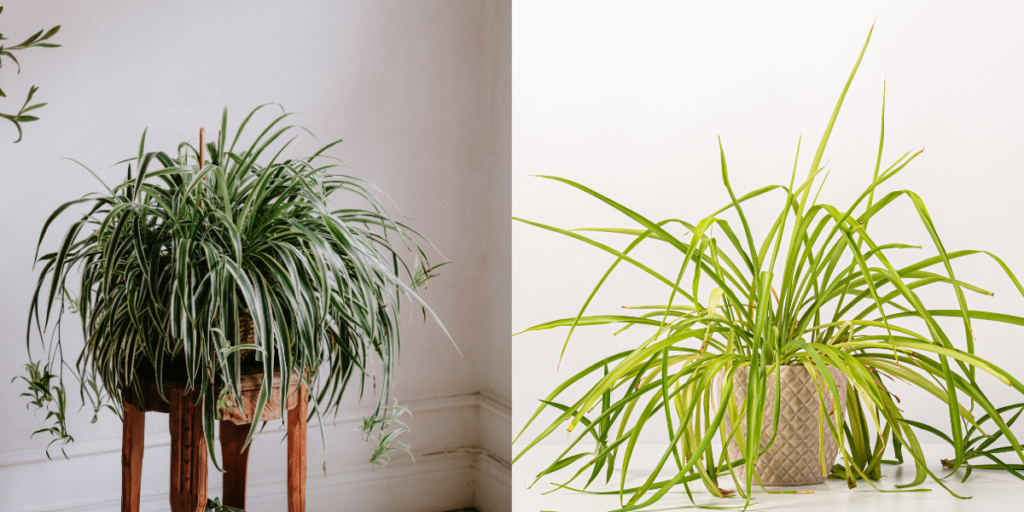Chlorophytum comosum ‘Bonnie’: A Vibrant Addition to Your Indoor Garden
The Chlorophytum comosum ‘Bonnie’ is a delightful addition to any indoor space. This unique cultivar of the spider plant is renowned for its captivating curly leaves that add a playful touch to your home decor. The vibrant green foliage, often adorned with creamy white stripes, creates a visually appealing contrast.
Beyond its aesthetic appeal, the Chlorophytum comosum ‘Bonnie’ is a resilient and low-maintenance plant. It thrives in various lighting conditions, from bright indirect light to moderate shade. This adaptability makes it suitable for a wide range of indoor environments, including living rooms, bedrooms, and offices.
One of the most endearing characteristics of this plant is its ability to produce plantlets or “spiderettes” that dangle from the mother plant. These plantlets can be easily propagated to create new, independent plants, making it a rewarding experience for plant enthusiasts.
Whether you’re a seasoned plant parent or a beginner, the ‘Bonnie’ is an excellent choice to bring a touch of nature’s beauty into your home. Its low-maintenance nature, attractive foliage, and air-purifying qualities make it a truly delightful companion.
Chlorophytum comosum ‘Bonnie’: A Vibrant Indoor Plant

Overview
The Chlorophytum comosum ‘Bonnie’ is a captivating indoor plant that belongs to the Asparagaceae family. This cultivar is distinguished by its unique, curly foliage, which adds a whimsical touch to any indoor space. Its vibrant green leaves, often adorned with creamy white stripes, create a visually appealing contrast.
Key Features
- Curly Foliage: The most striking feature of the Chlorophytum comosum ‘Bonnie’ is its curly leaves. This distinctive characteristic sets it apart from other spider plant varieties and adds a playful element to your indoor garden.
- Low Maintenance: This plant is renowned for its low-maintenance nature. It can tolerate a wide range of lighting conditions, from bright indirect light to moderate shade.It needs only minimal watering, making it perfect for busy individuals or beginners in plant care.
- Air-Purifying Qualities: Like other spider plants, the Chlorophytum comosum ‘Bonnie’ is an excellent air purifier. It helps remove harmful toxins and pollutants from the air, improving indoor air quality.
- Easy Propagation: This plant is easily propagated through its plantlets, or “spiderettes.” These small plantlets can be detached from the mother plant and rooted in soil or water to create new plants.
- Versatile Placement: The Chlorophytum comosum ‘Bonnie’ can be placed in various locations throughout your home. It can thrive on a tabletop, hanging basket, or as a floor plant. Its adaptability makes it a versatile choice for any indoor environment.
Whether you’re a seasoned plant enthusiast or a beginner, the ‘Bonnie’ is an excellent choice to enhance your indoor space. Its low-maintenance nature, attractive foliage, and air-purifying qualities make it a delightful addition to any home or office.
Natural Habitat and Origins of Chlorophytum comosum ‘Bonnie’
Natural Habitat
While the exact origins of the Chlorophytum comosum ‘Bonnie’ cultivar are not definitively known, its parent species, Chlorophytum comosum, is native to tropical and subtropical regions of Africa. These areas are known for their warm climate, high moisture levels, and plentiful rainfall. In its natural habitat, the spider plant thrives in various environments, including forests, grasslands, and rocky outcrops.
Evolution and Domestication
The Chlorophytum comosum, often referred to as the spider plant, has been cultivated for centuries. Its adaptability and ease of care have made it a popular houseplant worldwide. Over time, breeders have developed numerous cultivars, including the Chlorophytum comosum ‘Bonnie,’ through selective breeding techniques.
Adaptation to Indoor Environments
Despite its tropical origins, the Chlorophytum comosum ‘Bonnie’ has adapted well to indoor environments. It can adapt to various lighting conditions, ranging from bright indirect light to low light. Its ability to thrive in various lighting conditions makes it a versatile houseplant suitable for different homes and offices.
Air-Purifying Benefits
One of the reasons for the popularity of the ‘Bonnie’ is its air-purifying properties. It effectively removes harmful toxins and pollutants from the air, such as formaldehyde, benzene, and xylene. This makes it a great option for enhancing indoor air quality and promoting a healthier living space.
By understanding the natural habitat and origins of the ‘Bonnie,’ we can appreciate its adaptability and resilience. With proper care, this beautiful plant can thrive in your home for many years to come
Ideal Growing Conditions for Chlorophytum comosum ‘Bonnie’

The Chlorophytum comosum ‘Bonnie’ is a relatively low-maintenance plant that can thrive in a variety of indoor conditions. However, providing the optimal growing conditions will help ensure its health and vitality.
Light:
- Bright, Indirect Light: This plant prefers bright, indirect light. A south-facing window is ideal, but it can also tolerate lower light conditions.
- Avoid Direct Sunlight: Direct sunlight can scorch the leaves, so it’s important to avoid placing it in direct sunlight, especially during the hottest part of the day.
Temperature:
- Warm Temperatures: The Chlorophytum comosum ‘Bonnie’ thrives in warm temperatures, ideally between 65°F and 75°F (18°C and 24°C).
- Avoid Cold Drafts: Protect the plant from cold drafts, as they can damage the leaves.
Humidity:
- Moderate Humidity: This plant prefers moderate humidity levels. If the air is dry, mist the leaves occasionally or use a humidifier to increase the humidity.
Watering:
- Well-Drained Soil: The soil should be well-draining to prevent root rot.
- Watering Schedule: Give the plant a thorough watering once the top inch of soil is dry to the touch.Take care not to overwater, as it can lead to root rot.
- Reduce Watering in Winter: Decrease watering in the winter months when the plant’s growth slows down..
Fertilizing:
- Fertilizer: Once a month during the growing season (spring and summer), provide the plant with a balanced liquid fertilizer diluted to half strength.
- Avoid Over-Fertilizing: Over-fertilizing can damage the plant, so it’s important to follow the fertilizer instructions carefully.
By providing these ideal growing conditions, you can help your ‘Bonnie’ thrive and add a touch of beauty to your home.
Light and Temperature Needs for Chlorophytum comosum ‘Bonnie’
Light Requirements
- Bright, Indirect Light: The Chlorophytum comosum ‘Bonnie’ thrives in bright, indirect light. A south-facing window is ideal, as it provides plenty of light without the harsh, direct rays of the sun.
- Tolerates Lower Light: While it prefers bright light, this plant can also tolerate lower light conditions. However, in low-light situations, the growth rate may slow down, and the leaf color may become less vibrant.
- Avoid Direct Sunlight: Direct sunlight can scorch the leaves of the Chlorophytum comosum ‘Bonnie.’ To prevent this, avoid placing the plant in direct sunlight, especially during the hottest part of the day.
Temperature Preferences
- Warm Temperatures: This plant prefers warm temperatures, ideally between 65°F and 75°F (18°C and 24°C). It can tolerate slightly higher temperatures, but it’s important to avoid extreme heat.
- Avoid Cold Drafts: Cold drafts can damage the leaves of the Chlorophytum comosum ‘Bonnie.’ Protect the plant from cold air currents, especially during the winter months.
- Nighttime Temperatures: While warm daytime temperatures are ideal, it’s important to allow the plant to cool down at night. A slight temperature drop at night can help regulate the plant’s growth and overall health.
By understanding the light and temperature needs of the ‘Bonnie,’ you can provide the optimal growing conditions for this beautiful plant. With proper care, it will thrive and add a touch of green to your home or office.
Soil, Watering, and Fertilization Tips for Chlorophytum comosum ‘Bonnie’
Soil Requirements
- Well-Drained Soil: The Chlorophytum comosum ‘Bonnie’ thrives in well-draining soil. A well-draining potting mix will allow excess water to drain freely, preventing root rot.
- Potting Mix: A good potting mix for this plant should be a combination of potting soil and perlite or sand. This blend will ensure proper drainage and airflow..
- Repotting: Repot your Chlorophytum comosum ‘Bonnie’ every 1-2 years or when the plant becomes root-bound. Repotting in a slightly larger pot with fresh potting mix will encourage healthy growth.
Watering Needs
- Regular Watering: Water your Chlorophytum comosum ‘Bonnie’ regularly, but avoid overwatering. Let the top inch of soil dry before watering again.
- Avoid Soggy Soil: Soggy soil can lead to root rot, so it’s important to allow the soil to dry out slightly before watering again.
- Reduce Watering in Winter: During the winter months, when the plant is less active, reduce the frequency of watering.
Fertilization
- Fertilizer: Fertilize your Chlorophytum comosum ‘Bonnie’ once a month during the growing season (spring and summer) with a balanced liquid fertilizer diluted to half strength.
- Avoid Over-Fertilizing: Over-fertilizing can damage the plant, so it’s important to follow the fertilizer instructions carefully.
- Winter Fertilization: Reduce or stop fertilizing during the winter months when the plant is dormant.
By following these soil, watering, and fertilization tips, you can ensure the health and vitality of your ‘Bonnie’. With proper care, this beautiful plant will thrive and add a touch of green to your indoor space.
Common Issues and Solutions for Chlorophytum comosum ‘Bonnie’

While the Chlorophytum comosum ‘Bonnie’ is a relatively low-maintenance plant, it can still experience some common issues. Here are some of the most common problems and their solutions:
1. Brown Leaf Tips:
- Cause: Brown leaf tips are often caused by low humidity, excessive heat, or mineral buildup in the soil.
- Solution: Boost humidity by misting the plant regularly or placing a humidifier nearby. Ensure the plant is not exposed to excessive heat or cold drafts. Repot the plant in fresh, well-draining soil to remove mineral buildup.
2. Yellowing Leaves:
- Cause: Yellowing leaves can be caused by overwatering, underwatering, or nutrient deficiencies.
- Solution: Adjust your watering schedule to ensure the soil is evenly moist but not soggy. Apply a balanced liquid fertilizer to the plant during its growing season.
3. Pest Infestations:
- Cause: Common pests that can affect Chlorophytum comosum ‘Bonnie’ include mealybugs and spider mites.
- Solution: Treat the plant with insecticidal soap or neem oil to eliminate pests. In cases of severe infestation, consider applying a systemic insecticide.
4. Root Rot:
- Cause: Excessive watering and inadequate drainage can cause root rot.
- Solution: Repot the plant in well-draining soil and adjust your watering schedule. Remove any rotten roots during repotting.
By addressing these common issues promptly, you can keep your ‘Bonnie’ healthy and thriving. Regular monitoring and timely care will ensure that your plant remains beautiful for years to come.
Pet Safety and Toxicity Concerns for Chlorophytum comosum ‘Bonnie’
Pet-Friendly Plant
The good news is that the Chlorophytum comosum ‘Bonnie’ is generally considered safe for pets, including cats and dogs. It is not toxic to animals and does not pose a significant threat if ingested.
However, as with any houseplant, it’s important to monitor your pets’ interactions with the plant. While the plant itself is not toxic, excessive ingestion of any plant material can cause digestive upset in pets.
Preventive Measures
To ensure the safety of your pets, consider the following tips:
- Keep Out of Reach: Place the plant in an area that is inaccessible to pets, such as a high shelf or hanging basket.
- Monitor Your Pets: Keep an eye on your pets and their interactions with the plant. If you notice any signs of illness or unusual behavior, consult your veterinarian immediately.
- Choose Pet-Friendly Plants: If you have pets and are concerned about plant safety, consider choosing pet-friendly plants that are non-toxic to animals.
By taking these precautions, you can enjoy the beauty of the ‘Bonnie’ without worrying about the safety of your furry friends.
Benefits and Popularity of Chlorophytum comosum ‘Bonnie’ in the U.S.
The Chlorophytum comosum ‘Bonnie’ has gained significant popularity in the United States due to its numerous benefits and attractive appearance. This versatile houseplant offers a range of advantages that make it a favorite among plant enthusiasts and interior designers alike.
Air-Purifying Qualities
One of the primary reasons for the popularity of the Chlorophytum comosum ‘Bonnie’ is its air-purifying abilities. It effectively removes harmful toxins and pollutants from the air, such as formaldehyde, benzene, and xylene. This makes it a fantastic option for enhancing indoor air quality and fostering a healthier living space.
Low-Maintenance Nature
The Chlorophytum comosum ‘Bonnie’ is a low-maintenance plant that can thrive with minimal care. It is tolerant of various light conditions and can adapt to different watering schedules. This makes it an ideal choice for busy individuals or those who are new to plant care.
Aesthetic Appeal
The unique, curly foliage of the Chlorophytum comosum ‘Bonnie’ adds a touch of elegance and sophistication to any indoor space. Its vibrant green leaves, often adorned with white stripes, create a visually appealing contrast. This plant can be displayed in various ways, including hanging baskets, tabletop arrangements, or as a floor plant.
Easy Propagation
The Chlorophytum comosum ‘Bonnie’ is easily propagated through its plantlets, or “spiderettes.” These small plantlets can be detached from the mother plant and rooted in soil or water to create new plants. This makes it a great choice for plant enthusiasts who enjoy propagating their own plants.
Overall, the ‘Bonnie’ is a versatile and attractive houseplant that offers numerous benefits. Its air-purifying qualities, low-maintenance nature, and aesthetic appeal have made it a popular choice among American homeowners and businesses alike.
Frequently Asked Questions
1. How often should I water my Chlorophytum comosum ‘Bonnie’?
Water your Chlorophytum comosum ‘Bonnie’ when the top inch of soil feels dry to the touch. Reduce watering frequency during the winter months when the plant is less active.
2. Can I propagate my Chlorophytum comosum ‘Bonnie’?
Yes, you can easily propagate your Chlorophytum comosum ‘Bonnie’ through its plantlets, or “spiderettes.” Simply detach a plantlet from the mother plant and root it in water or soil.
3. How often should I fertilize my Chlorophytum comosum ‘Bonnie’?
Feed your plant a balanced liquid fertilizer, diluted to half strength, once a month during the growing season (spring and summer). Avoid over-fertilizing, as this can damage the plant.
4. What are the common pests that affect Chlorophytum comosum ‘Bonnie’?
Common pests that can affect ‘Bonnie’ include mealybugs and spider mites. Control these pests using insecticidal soap or neem oil.
5. Can I place my Chlorophytum comosum ‘Bonnie’ in low-light conditions?
While the Chlorophytum comosum ‘Bonnie’ prefers bright, indirect light, it can tolerate lower light conditions. However, in low-light situations, the growth rate may slow down, and the leaf color may become less vibrant.









Post Comment